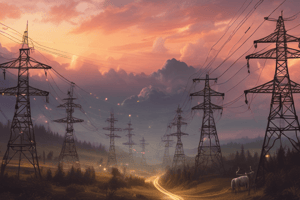Podcast
Questions and Answers
What is the purpose of using a Super Grid?
What is the purpose of using a Super Grid?
To connect and interconnect different power stations and load centers for efficient energy generation and transmission.
What were the voltage levels at which the first electric networks operated?
What were the voltage levels at which the first electric networks operated?
- 25 Hz to 133 Hz (correct)
- 60 Hz (correct)
- 2.3 kV
- 50 Hz (correct)
The first electric network was established in New York City by Thomas Edison in 1882.
The first electric network was established in New York City by Thomas Edison in 1882.
True (A)
Which of the following components is essential in power generation stations?
Which of the following components is essential in power generation stations?
The voltage generated by a generator is typically transformed by a __________ to a higher transmission voltage.
The voltage generated by a generator is typically transformed by a __________ to a higher transmission voltage.
What type of turbines can serve as a prime mover in power generation?
What type of turbines can serve as a prime mover in power generation?
What is the function of a high voltage substation?
What is the function of a high voltage substation?
What primary problem is associated with transmission lines?
What primary problem is associated with transmission lines?
Flashcards are hidden until you start studying
Study Notes
Power Transmission Process
- Power transmission is the process of transporting electrical energy from generation stations to distribution systems.
- Super Grid: An interconnected network of high-voltage transmission lines that spans large geographical distances, enabling efficient and reliable power transfer between different regions.
- Interconnected systems: An interconnected power system, often referred to as a grid, offers advantages for energy management like:
- Fewer generators needed for peak load
- Spinning reserve
- More economical and reliable energy production
- Enables efficient transfer of power from one region to another
- Key Components of a Power System
- Generation stations (plants): Generate electrical power using prime movers like turbines and internal combustion engines.
- Transmission system: Carries high-voltage power from generation stations to substations, typically at extra high voltage (EHV) levels.
- Distribution systems: Delivers power to consumers at lower voltage levels.
- Transformers and Substations: Facilitates voltage transformation between different levels, switching operations, fault isolation, and safe maintenance.
- Essential components of power generation stations:
- Generators: Convert mechanical energy to electrical energy.
- Transformers: Step-up transformers increase voltage to transmission levels.
- High-voltage substation: Connects generators to the transmission system via circuit breakers, bus-bars, isolators, voltage transformers (VTs), and current transformers (CTs).
Transmission and sub-transmission
- Transmission network: Transports electrical energy from generation units to distribution centers.
- Voltage transformation: Step-up transformers are used to increase voltage at generation stations, while step-down transformers decrease voltage at distribution centers.
- History of Electric Networks:
- 1882: Thomas Edison established the first DC electric network in New York City.
- 1885: The invention of the transformer allowed for AC networks to become more widespread due to their reduced power loss during transmission.
- 1893: Edison's company installed the first three-phase system at 2.3 kV.
- 1969: The first 765 kV extra high voltage (EHV) transmission line was put into operation in the United States.
- Standardization of Frequency: The need for interconnections and parallel operations led to the adoption of standard frequencies of 60 Hz or 50 Hz.
- Evolution of Transmission Voltages: Transmission voltages have steadily increased over time to improve transmission efficiency.
Studying That Suits You
Use AI to generate personalized quizzes and flashcards to suit your learning preferences.



